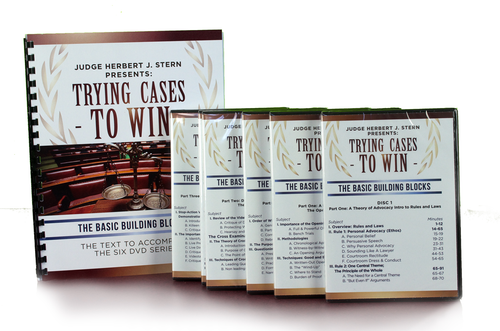The Basic Building Blocks
This foundation to the Stern Video Library features demonstrations by Herbert J. Stern with Judah Best, Benjamin Civiletti, Bruce Goldstein, John Lowe and Michael Tigar.
Click below description to view an excerpt from: Trying Cases to Win, The Basic Building Blocks that discusses the importance of the opening statement.
Key Points Covered:
- An introduction to the rules of laws of advocacy
- How to organize, prepare and deliver the most powerful possible opening statement in your case
- How to formulate questions and argue your case to the jury right through the witness without leading the witness or relying on written questions on either direct or cross-examination
- The ofganization and delivery of the most effective summation with video stop-action and critiques.
Detailed Course Outline
DISK 1
- Overview: Rules and Laws
- Rule 1: Personal Advocacy (Ethos)
- Personal Belief
- Persuasive speech
- Why personal advocacy
- Sounding like a lawyer
- Courtroom rectitude
- Courtroom dress and conduct
- Rule 2: One Central Theme: The principle of the Whole
- The need for a central theme
- "But even if" arguments
- Buffet theory
- "Nay more" arguments
- Cumulating weak arguments
- Liability and damages
- The best theme
- Rule 3: Emotional Appeal (Pathos)
- "Laws"
- Primacy and recency
- Vividness
- Frequency
DISK 2
- Importance of the Opening Statement
- Personal Belief
- Bench Trials
- Methodologies
- Chronological approach
- Witness-by-witness approach
- An opening argument
- Techniques: Good and Bad
- Written-out openings
- The "wind-up"
- Where to stand
- Burden of proof
- Promises of proof
- Motions in limine
- Dealing with weakness
- Stop-Action Videotape Demonstration and Critique
- Introduction to Calley tape
- Prosecution opening
- Defendant's opening
- Discussion of tape
- Additional Observations
DISK 3
- Order of Witnesses
- Generally
- Parties
- Corroborating witnesses
- Rebuttal
- The Purposes of Direct Examination
- Questioning Witnesses
- Presenting witnesses
- Written questions
- Practice by witnesses
- Formulating questions
- Narratives
- Leading questions
- Where to stand
- Refreshing recollection
- Preparing for Direct Examination
- Preparing generally
- Sensitizing witnesses
- Nervous witnesses
- Repeating Testimony
- Exhibits as Evidence
- Exhibits generally
- Laying a foundation
- Offering the exhibit
- Proving Conversations Stop-Action Videotape
- Demonstration and Critique
- Introduction to Calley Tape
- Direct examination
DISK 4
- THE DIRECT EXAMINATION
- Review of the Videotape
- Critique of demonstration
- Protecting witnesses
- Hearsay and exceptions
- THE CROSS EXAMINATION
- The Theory of Cross-examination
- Introduction
- Purpose of cross-examination
- The point of an examination
- Techniques of Cross-Examination
- Leading questions
- Purpose of cross-examination
- "Yes or no" answers
- Appeals to the judge
- Structure and errors
- Inconsistent statements
- When to impeach
- Blind alleys
DISK 5
- THE DIRECT EXAMINATION
- voir Dire of Witnesses
- Stop-Action Videotape Demonstration and Critique
- Introduction to Calley tape
- Cross-examination
- Critique of demonstration
- APPLYING THE PRINCIPLES TO THE CASE
- Forming a Partnership
- Deciding on a Central Theme
- How to decide
- Videotape of Terry Eyre
- Review of videotape
- The central theme
- Proving drunkenness
DISK 6
- Stop-Action Videotape Demonstration and Critique
- Introduction to Killeen opening
- Killeen opening
- Critique of demonstration
- The Importance of Martin Gunning
- Identifying the importance
- Live preparation of witness
- Live direct examination
- Critique of demonstration
- Videotape cross-examination
- Critique of demonstration
- Summations
- Preparation
- Things to emphasize
- Mistakes
Viewing Time: 12 hours



